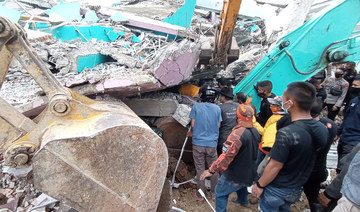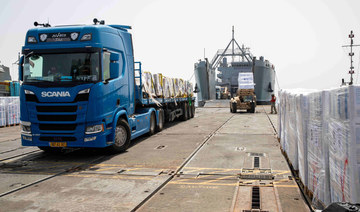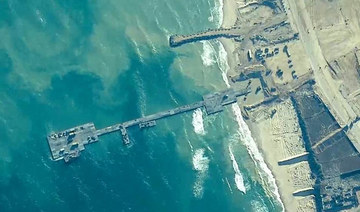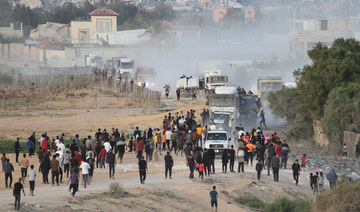JAKARTA: At least 56 people have been killed after an earthquake struck Indonesia’s West Sulawesi province on Friday, the disaster mitigation agency (BNPB) said on Sunday, the latest in a string of disasters to hit the Southeast Asian country.
More than 820 people were injured and about 15,000 left their homes after the 6.2 magnitude quake, the BNPB said. Some sought refuge in the mountains, while others went to cramped evacuation centers, witnesses said.
Dwikorita Karnawati, the head of Indonesia’s meteorological, climatology and geophysical agency (BMKG), has said that another quake in the region could potentially trigger a tsunami.
Straddling the so-called Pacific Ring of Fire, Indonesia is regularly hit by earthquakes. In 2018, a devastating 6.2-magnitude quake and subsequent tsunami struck the city of Palu, in Sulawesi, killing thousands.
Just two weeks into the new year, the world’s fourth-most populous country is again battling several disasters.
Floods in North Sulawesi and South Kalimantan province each have killed at least five this month, while landslides in West Java province have killed at least 28, authorities said.
On Jan. 9, a Sriwijaya Air jet crashed into the Java Sea with 62 onboard.
East Java’s Semeru mountain erupted late on Saturday, but there have been no reports of casualties or evacuations.
Dwikorita said extreme weather and other “multi-dangers” of hydrometeorology are forecast in the coming weeks.
Quake death toll at 56 as Indonesia struggles with string of disasters
https://arab.news/mchb3
Quake death toll at 56 as Indonesia struggles with string of disasters
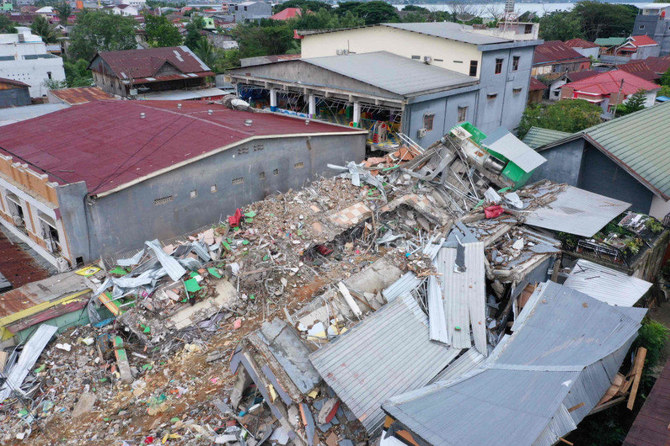
- Disaster mitigation agency says more than 820 people were injured
- About 15,000 left their homes after the 6.2 magnitude quake
Divisions, elections and Assad lay bare Europe’s Syrian quagmire
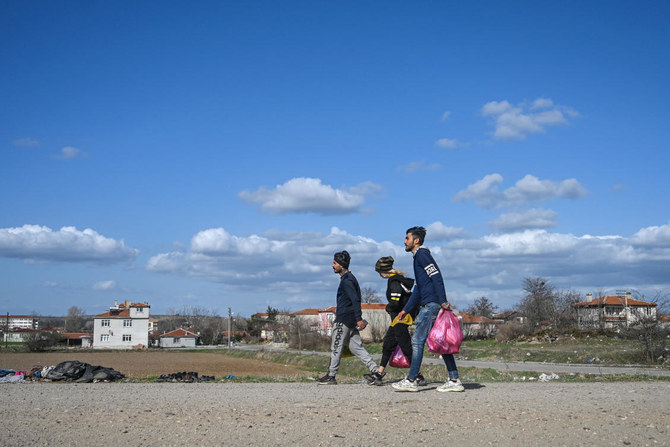
Syria has become a forgotten crisis that nobody wants to stir amid the war raging between Israel and Islamist Palestinian militants Hamas and tensions growing between Iran and Western powers over its regional activities.
More than 5 million refugees mostly in Lebanon and Turkiye and millions more displaced internally have little prospect of returning home with political stability no closer than since the uprising against President Bashar Assad’s rule began in 2011.
Funding to support them is dropping with the likes of the World Food Programme reducing its aid. Difficulties to host refugees are surfacing, notably in Lebanon, where the economic situation is perilous and a call to send Syrians home is one of the rare issues that unites all communities.
“We have no levers because we never resumed relations with the Assad regime and there are no indications anybody really will,” said a former European envoy to Syria.
“Even if we did, why would Syria offer carrots to countries that have been hostile to him and especially taking back people who opposed him anyway.”
Major European and Arab ministers along with key international organizations meet for the 8th Syria conference next Monday, but beyond vague promises and financial pledges, there are few signs that Europe can take the lead.
The talks come just ahead of the European elections on June 6-9 in which migration is a divisive issue among the bloc’s 27-member states. With far-right and populist parties already expected to do well, there is little appetite to step up refugee support.
The conference itself has changed from eight years ago. The level of participation has been downgraded. The likes of Russia, the key actor backing Assad, is no longer invited after its invasion of Ukraine. The global geopolitical situation and drop in the conflict’s intensity keeps it off radars.
There are divisions within the EU on the subject. Some countries such as Italy and Cyprus are more open to having a form of dialogue with Assad to at least discuss possible ways to step up voluntary returns in conjunction with and under the auspices of the United Nations.
However, others, like France which acknowledges the pressure the refugees are weighing on Lebanon and fears broader conflict between Iran-backed Hezbollah and Israel, remain steadfast that there can be no discussion with the Assad regime until key conditions are met.
But the reality on the ground is forcing a discussion on the issue.
Demonstrating the tensions between the EU and the countries hosting refugees, Lebanese MPs threatened to reject the bloc’s 1 billion euro package announced earlier this month, slamming it as a “bribe” to keep refugees in limbo in Lebanon instead of resettling them permanently in Europe or sending them back home to Syria.
Caretaker Prime Minister Najib Mikati, who unlike in previous years is not due to attend the Brussels conference, has said that Beirut would start dealing with the issue itself without proper international assistance.
The result has been an upswing in migrant boats from Lebanon to Europe, with nearby Cyprus and increasingly Italy, too, as the main destinations, prompting some countries to ring alarm bells fearing a flood of new refugees into the bloc.
“Let me be clear, the current situation is not sustainable for Lebanon, it’s not sustainable for Cyprus and it’s not sustainable for the European Union. It hasn’t been sustainable for years,” Cypriot President Nikos Christodoulides said this month during a visit to Lebanon.
Highlighting the divisions in Europe, eight countries — Austria, Czech Republic, Cyprus, Denmark, Greece, Italy, Malta and Poland — last week issued a joint statement after talks in Cyprus, breaking ranks with the bloc’s previous positions.
They argued that the dynamics in Syria had changed and that while political stability did not exist yet, things had evolved sufficiently to “re-evaluate the situation” to find “more effective ways of handling the issue.”
“I don’t think there will be a big movement in terms of EU attitude, but perhaps some baby steps to engage and see if more can be done in various areas,” said a diplomat from one of the countries that attended the talks in Cyprus.
Another was more blunt.
“Come Tuesday Syria will be swept under the carpet and forgotten. The Lebanese will be left to deal with the crisis alone,” said a French diplomat.
More aid getting from US pier to people in Gaza, officials say, after troubled launch
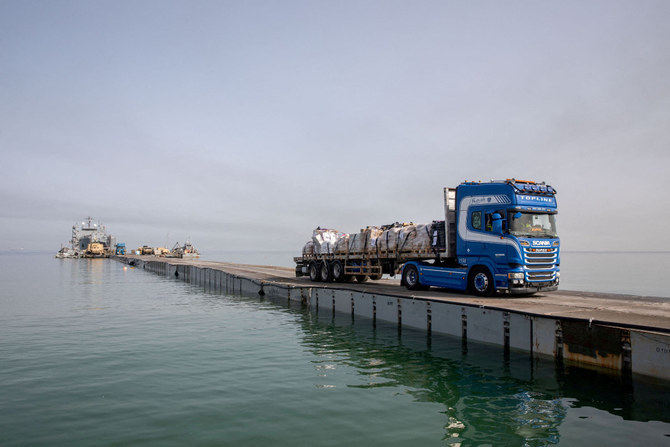
- Crowds overrun some of the first trucks coming from the new US-led sea route and taking its contents over the weekend, leading to a two-day suspension of aid distribution
- At maximum capacity, the pier would bring in enough food for 500,000 of Gaza’s people. US officials stressed the need for flow through open land crossings for the remaining 1.8 million
WASHINGTON: A six-day-old US pier project in Gaza is starting to get more aid to Palestinians in need but conditions are challenging, US officials said Thursday. That reflects the larger problems bringing food and other supplies to starving people in the besieged territory.
The floating pier had a troubled launch, with crowds overrunning some of the first trucks coming from the new US-led sea route and taking its contents over the weekend. One man in the crowd was shot dead in still-unexplained circumstances. It led to a two-day suspension of aid distribution.
The US military worked with the UN and Israeli officials to select safer alternate routes for trucks coming from the pier, US Vice Admiral Brad Cooper told reporters Thursday.
As a result, the US pier on Wednesday accounted for 27 of the 70 total trucks of aid that the UN was able to round up from all land and sea crossings into Gaza for distribution to civilians, the United States said.
That’s a fraction of the 150 truckloads of food, emergency nutrition treatment and other supplies that US officials aim to bring in when the sea route is working at maximum capacity.
Plus, Gaza needs 600 trucks entering each day, according to the US Agency for International Development, to curb a famine that the heads of USAID and the UN World Food Program have said has begun in the north and to keep it from spreading south.
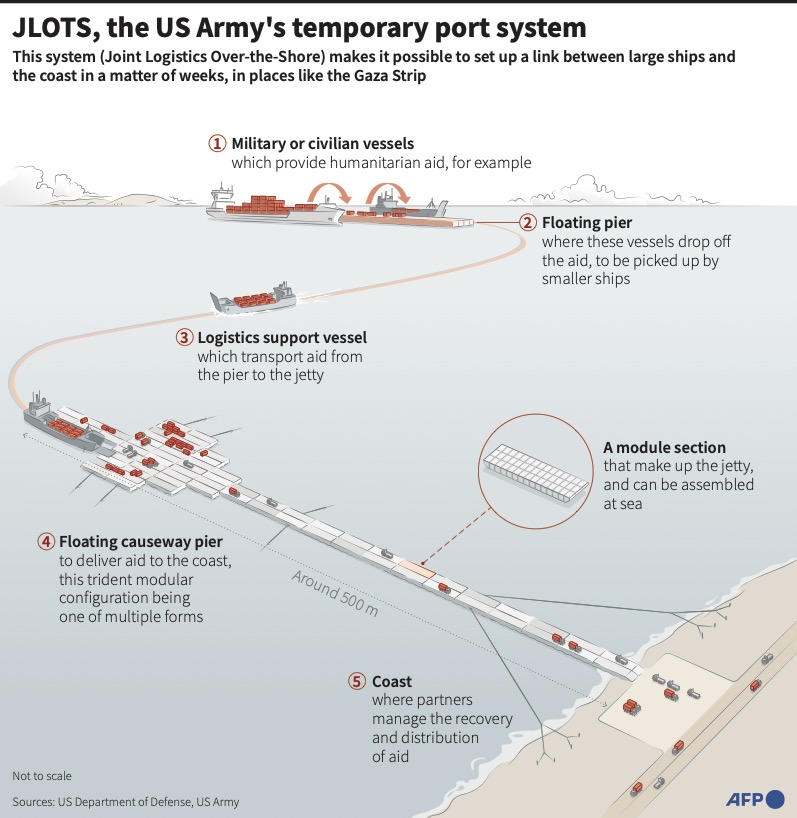
Only one of the 54 trucks that came from the pier Tuesday and Wednesday encountered any security issues on their way to aid warehouses and distribution points, US officials said. They called the issues “minor” but gave no details.
A deepening Israeli offensive in the southern city of Rafah has made it impossible for aid shipments to get through the crossing there, which is a key source for fuel and food coming into Gaza. Israel says it is bringing aid in through another border crossing, Kerem Shalom, but humanitarian organizations say Israeli military operations make it difficult for them to retrieve the aid there for distribution.
The Biden administration last week launched the $320 million floating pier for a new maritime aid route into Gaza as the seven-month-old Israel-Hamas war and Israeli restrictions on land crossings have severely limited food deliveries to 2.3 million Palestinians.
For all humanitarian efforts, “the risks are manifold,” Daniel Dieckhaus, USAID’s response director for Gaza, said at a briefing with Cooper. “This is an active conflict with deteriorating conditions.”
Dieckhaus rejected charges from some aid groups that the pier is diverting attention from what the US, UN and relief workers say is the essential need for Israel to allow full access to land crossings for humanitarian shipments.
For instance, Jeremy Konyndyk, a former USAID official now leading Refugees International, tweeted that “the pier is humanitarian theater.”
“I would not call, within a couple of days, getting enough food and other supplies for tens of thousands of people for a month theater,” Dieckhaus said Thursday when asked about the criticism.
At maximum capacity, the pier would bring in enough food for 500,000 of Gaza’s people. US officials stressed the need for flow through open land crossings for the remaining 1.8 million.
Netanyahu will soon address joint session of US Congress, House Speaker Johnson says
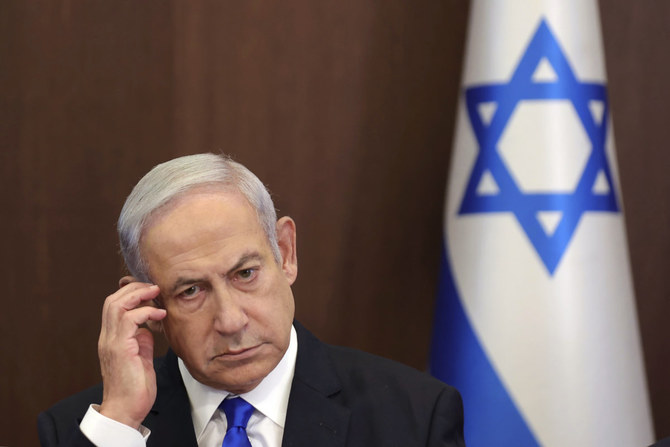
- Johnson made the announcement in a keynote speech at the Israeli embassy’s annual Independence Day reception
- The diplomatic gathering came amid strains between Biden and Netanyahu over a US push for Israel to do more to protect Palestinian civilians in the war against Hamas militants in Gaza
WASHINGTON: Republican US House Speaker Mike Johnson announced on Thursday that Israeli Prime Minister Benjamin Netanyahu would soon address a joint meeting of Congress amid heightened tensions with President Joe Biden over the Israeli leader’s handling of the war in Gaza.
Delivering a keynote speech at the Israeli embassy’s annual Independence Day reception, Johnson, the top congressional Republican and a critic of the Democratic president’s Israel policy, said it would be “a strong show of support for the Israeli government in their time of greatest need.”
Such a speech is sure to further anger some progressive Democrats who are increasingly critical of Israel’s military campaign in Gaza and Biden’s support for it.
The diplomatic gathering came amid strains between Biden and Netanyahu over a US push for Israel to do more to protect Palestinian civilians in the war against Hamas militants in Gaza.
The embassy gave equal billing to a speech by Democratic US Representative Pete Aguilar, who shared the high-profile platform with Johnson at a more subdued event under the shadow of the Gaza war. He said US support for Israel was “iron-clad.”
Speaking first, Johnson said to applause from the heavily pro-Israel audience: “Tonight I’m happy to announce something else to you. We will soon be hosting Prime Minister Netanyahu at the Capitol for a joint session of Congress.”
Successive US administration have usually sent a high-level official to the Independence Day receptions, reflecting Israel’s status as Washington’s top Middle East ally.
Vice President Kamala Harris, who in recent months has called the situation in Gaza a “humanitarian catastrophe” and has urged a ceasefire, delivered last year’s keynote, mostly extolling US backing for Israel. Homeland Secretary Alejandro Mayorkas spoke the year before.
An Israeli official said this year that the embassy wanted to honor lawmakers in a bipartisan way with high-profile speaking roles in appreciation for congressional approval of new US military aid to Israel.
The reception took place on the same night as a White House state dinner for Kenyan President William Ruto, which the Israeli official said created a scheduling conflict for senior members of the administration. Other more junior administration officials were on the embassy’s guest list, according to the Israeli official.
The White House did not immediately respond to a request for comment on the absence of a senior Biden aide from the speakers’ list.
Three US troops have non-combat injuries during Gaza pier operation
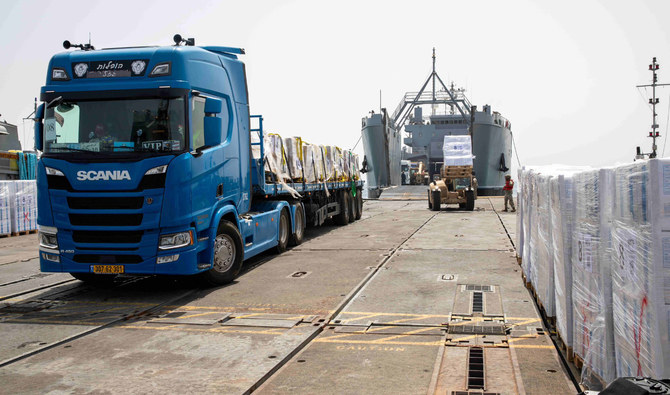
WASHINGTON: Three US troops suffered non-combat injuries in the effort to make a temporary pier off the coast of Gaza into a conduit for humanitarian aid, with one in critical condition at an Israeli hospital, US officials said on Thursday.
The injuries were the first for US forces during the latest operation to bring humanitarian aid to Palestinians.
The pier was announced by US President Joe Biden in March and involved the military assembling the floating structure off the coast. Estimated to cost $320 million for the first 90 days and involve about 1,000 US service members, it went into operation last week.
US Vice Admiral Brad Cooper, the deputy commander of US Central Command, told reporters that two of the troops had a sprained ankle and a minor back injury.
“Two were very minor, routine injuries. Those individuals returned to duty,” Cooper said.
A third service member, injured on a ship at sea, was medically evacuated to a hospital in Israel, he said. A US defense official, speaking on the condition of anonymity, said the individual was in critical condition.
US lawmakers have voiced concern about the risks to positioning US troops off the coast of Gaza. Biden has said they will not step foot in the war-torn city itself.
The Pentagon has said it will prioritize the safety of US military personnel.
“We’re clear eyed and we continue to look at force protection all day, every day and as it stands now we assess the operations can continue,” Cooper said.
Social media images showed a US air defense system, known as the Counter Rockets, Artillery and Mortars (CRAM), firing into the sky while on the pier. US officials said troops were testing the system.
Daniel Dieckhaus of the US Agency for International Development said that since the pier opened last week, about 506 metric tons of aid had been handed off to humanitarian groups inside Gaza. About a third of that has not yet been distributed but would be soon, he said.
Massive cradle of baby stars revealed in new space telescope images
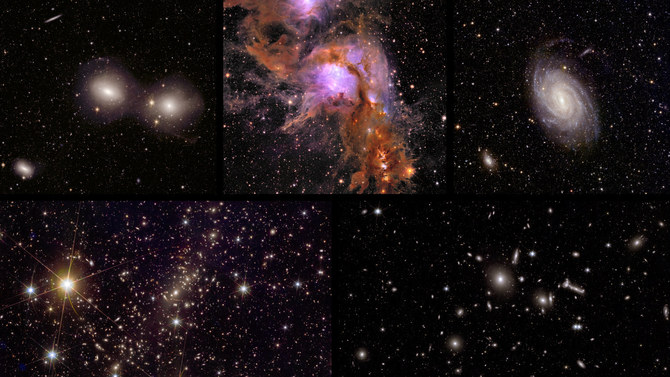
- The European Space Agency released the photos from the Euclid observatory on Thursday
- Euclid will spend the next several years observing billions of galaxies covering more than one-third of the sky
CAPE CANAVERAL, Florida: A massive cradle of baby stars has been observed in new detail by a European space telescope, adding to its celestial collection of images.
The European Space Agency released the photos from the Euclid observatory on Thursday.
They were taken following the telescope’s Florida launch last year as a warm-up act to its main job currently underway: surveying the so-called dark universe.
From its perch 1 million miles (1.6 million kilometers) from Earth, Euclid will spend the next several years observing billions of galaxies covering more than one-third of the sky.
The shape and size of all these galaxies can help scientists understand the mysterious dark energy and dark matter that make up most of the universe.
“Euclid is at the very beginning of its exciting journey to map the structure of the universe,” the space agency’s director general, Josef Aschbacher, said in a statement.
Among the newly released pictures is one of an enormous cradle of baby stars some 1,300 light-years away known as Messier 78. A light-year is 5.8 trillion miles. Euclid’s infrared camera peered through the dust enveloping the stellar nursery, revealing new regions of star formation, according to ESA.




